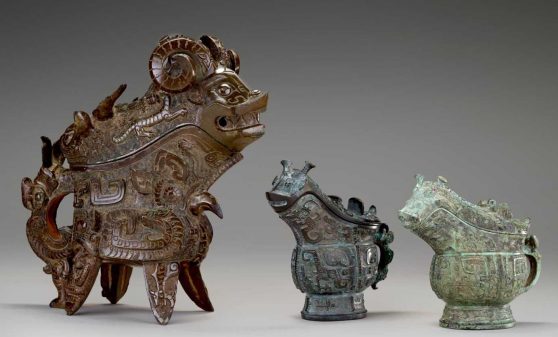Media Passes Are Available for International Symposium Held in Conjunction With the Exhibition “Anyang: China’s Ancient City of Kings”
Left to right: Ritual wine pouring vessel (gong) with masks (taotie), dragons, and real animals, Anyang or middle Yangzi region, ca. 1100 B.C., bronze, Gift of Eugene and Agnes E. Meyer, F1961.33a–b; Ritual wine-pouring vessel (gong) with masks (taotie) and dragons, middle or late Anyang period, ca. 1100 B.C., bronze, Gift of Arthur M. Sackler, S1987.279a–b; Ritual wine-pouring vessel (gong) with masks (taotie), dragons, and real animals, middle Anyang period, ca. 1150–1100 B.C., bronze, Purchase— Charles Lang Freer Endowment, F1939.53a–b (National Museum of Asian Art, Smithsonian Institution)
January 30, 2024 |
National Museum of Asian Art
| WHAT: |
Individual media passes for “Anyang: China’s Ancient City of Kings” symposium |
| WHEN: |
March 7–8; exhibition on view through April 28 |
| WHERE: |
Smithsonian’s National Museum of Asian Art, Arthur M. Sackler Gallery
1050 Independence Ave. S.W. |
| WHO: |
Keith Wilson, curator of Ancient Chinese art
Kyle Steinke, research curator |
Members of the media are invited to attend a two-day international symposium March 7–8 held in conjunction with the exhibition “Anyang: China’s Ancient City of Kings” at the National Museum of Asian Art. Bringing together specialists in a range of disciplines, the program will speak to the primary topics addressed in the exhibition including the 20th-century discovery of the Shang city and the advent of Chinese archaeology, the infrastructure that supported daily life at Anyang, the role of writing in its bureaucratic administration and the evolution of design and technology reflected in the products created in the city’s various craft workshops. Pre-registration is available on the museum’s website.
“Anyang: China’s Ancient City of Kings” is the first major exhibition in the United States dedicated to Anyang, the capital of ancient China’s Shang dynasty (occupied ca. 1250 B.C.–ca. 1050 B.C.), the source of China’s earliest surviving written records, a UNESCO World Heritage Site and the birthplace of Chinese archaeology. Composed of objects exclusively from the museum’s collection, “Anyang” brings together more than 200 artifacts to examine the Shang state and artistic achievements of those who lived in its capital some 3,000 years ago. Anyang holds a special connection with the National Museum of Asian Art. Beginning in 1928, archaeological work at the Bronze Age site was supervised by Academia Sinica, China’s first interdisciplinary research institute. One year later, Li Chi (1896–1979) assumed leadership of the excavations. At the time, he was also a staff member of the Freer Gallery of Art (1925–30). To promote archaeological practice in China, the museum supported Li and his first two seasons of work at Anyang. This collaboration, predicated on the advancement of scientific knowledge and the protection of cultural patrimony, marks an important chapter in the history of Sino-American relations.


